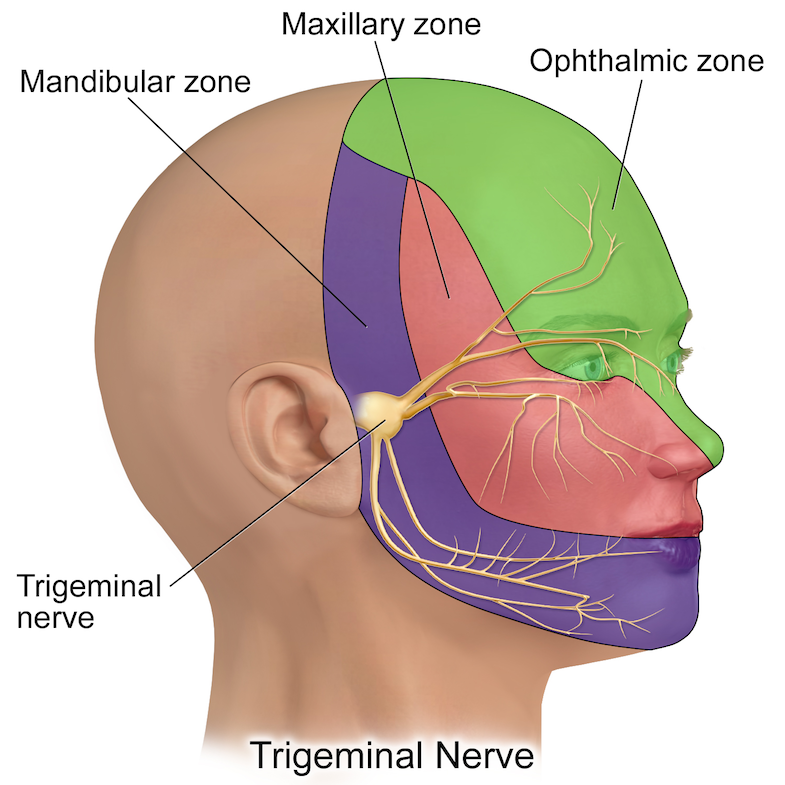Imagine a pain condition so severe that it can bring you to your knees without any warning. Trigeminal neuralgia is such a pain condition, diagnosed in just over 150,000 people in the U.S. every year.
What is trigeminal neuralgia?
Trigeminal neuralgia, also referred to as tic douloureux, is a chronic pain condition that occurs when the trigeminal nerve is damaged or malfunctioning. It can lead to severe and chronic pain in the face and head.
What is the main cause of trigeminal neuralgia?
One of the major causes of trigeminal neuralgia is nerve irritation, damage, or compression.
The trigeminal nerve originates behind your ear and branches out in three directions to enervate different parts of your face:
- Upper branch (ophthalmic) enervates the scalp, forehead, and front of the head
- Middle branch (maxillary) involves the cheek, upper jaw, top lip, teeth and gums, and the side of the nose
- Lower branch (mandibular) directs sensations in the lower jaw, teeth and gums, and bottom lip
When damage occurs to any of these parts, the malfunctioning nerve can cause severe pain in any of the areas it enervates.
There are a number of causes of nerve irritation, damage, or compression, including:
- Pressure on the trigeminal nerve, usually by a blood vessel exiting the brain stem, which wears away the protective coating around the nerve (the myelin sheath)
- Multiple sclerosis, a disease that causes deterioration of the myelin sheath
- Poorly managed diabetes, a common cause of nerve damage and neuropathic pain
- Shingles
- Trigeminal nerve compression from a tumor
- Arteriovenous malformation (tangled arteries and veins)
- Injury to the trigeminal nerve (due to sinus surgery, oral surgery, stroke, or facial trauma)
What does trigeminal neuralgia pain feel like?
Trigeminal neuralgia symptoms are fairly consistent, even if their occurrence is not. The severity of each symptom varies from patient to patient, though, and symptoms may come and go at irregular intervals.
Trigeminal neuralgia symptoms are typically felt in the face, neck, shoulders, and head. You may experience:
- Sharp, stabbing pain
- Dull, constant aching pain
- Sensitivity to light and sound
- Nausea
- Vomiting
- Burning
- Tingling
- Itching
For some reason, symptoms rarely occur at night. Symptoms can last from a few seconds to several days and can completely incapacitate the sufferer. The pain may be so intense that sufferers experience momentary loss of other senses, like sight and smell.
Most sufferers experience pain in only one side of the face, but in rare cases, both sides hurt. This results in pain that is debilitating.
Pain can be triggered by the slightest breeze or touch, shaving, eating, talking, or speaking. Even drinking water can trigger pain.
Trigeminal neuralgia suicidality: diagnosis saves lives
Diagnosing this intermittent and unpredictable pain is crucial. Trigeminal neuralgia is more than just a painful irritant; it can also be deadly. The suicide rate for trigeminal neuralgia sufferers in the U.S. may be as high as 25%, nearly double the rate of suicide in the general population.
Trigeminal neuralgia suicidality may be caused, in part, by the social isolation sufferers feel. Due to the unpredictable nature of their pain, they may avoid social interaction or change their daily pattern of activities, fearing an attack. Caring for a loved one with a chronic pain condition is a strain on relationships, and many sufferers find themselves alone.
Getting a proper diagnosis is the first step to treating this condition and improving a sufferer’s quality of life.
How do you test for trigeminal neuralgia?
No single test can diagnose trigeminal neuralgia definitively. Often it is misdiagnosed as a migraine. Although some treatments for migraine can help trigeminal neuralgia, without treating the underlying cause the pain will persist. Cluster headaches and temporomandibular joint disorder also may present similar symptoms (and require different treatments).
In most cases, your doctor will use the process of elimination as well as taking a complete medical history to check for conditions that may be causing your pain.
Your doctor may also use a magnetic resonance imaging (MRI) scan to rule out a tumor or to see if nerve compression is a visible and obvious cause. Sometimes a short course of antiseizure medications can diagnose trigeminal neuralgia (see treatments below).
Trigeminal neuralgia and occipital neuralgia have the same type of symptoms, with both responding well to similar treatments. If the initial type of nerve pain (neuralgia) is misdiagnosed, the treatments may still help.
What trigeminal neuralgia treatments work?
Trigeminal neuralgia treatments depend on what is causing your pain. In some cases, the cause is temporary and will resolve on its own. Sufferers can rest in a quiet, dark room and apply a cold or hot compress (if that doesn’t make the pain worse).
For trigeminal neuralgia that is caused by an underlying medical condition, treating symptoms will only go so far if the underlying condition remains. It is crucial to get a proper diagnosis that includes diagnosing cause of the disorder. Treating the underlying cause can help relieve your pain.
There are several medications your doctor may recommend for trigeminal neuralgia. Anticonvulsant medicines block pain signals to the brain. These medications include carbamazepine, oxcarbazepine, topiramate, gabapentin, pregabalin, clonazepam, phenytoin, lamotrigine, and valproic acid.
Antispasmodic medications relax muscles that may be pressing on the nerve as well.
In some cases, tricyclic antidepressants offer relief. Why they work on chronic pain is not well understood, but they may be helpful when used in conjunction with treating underlying conditions.
Your dentist or doctor can also try Botox (botulinum toxin A) if other treatments haven’t helped. Several injections into the muscles of your jaw can help to relax them without compromising your eating or speaking. If these muscles are compressing the trigeminal nerve, this may relieve your pain.
Surgical options are often the last resort for pain relief. Techniques such as microvascular decompression relieve pressure on the trigeminal nerve. Brain stereotactic radiosurgery (a.k.a gamma knife), balloon compression, and radiofrequency thermal lesioning are used to damage the trigeminal nerve, blocking pain signals.
When trigeminal neuralgia pain strikes, you don’t have to suffer. AZ Dentist is your Phoenix area emergency dentist. We can help.

